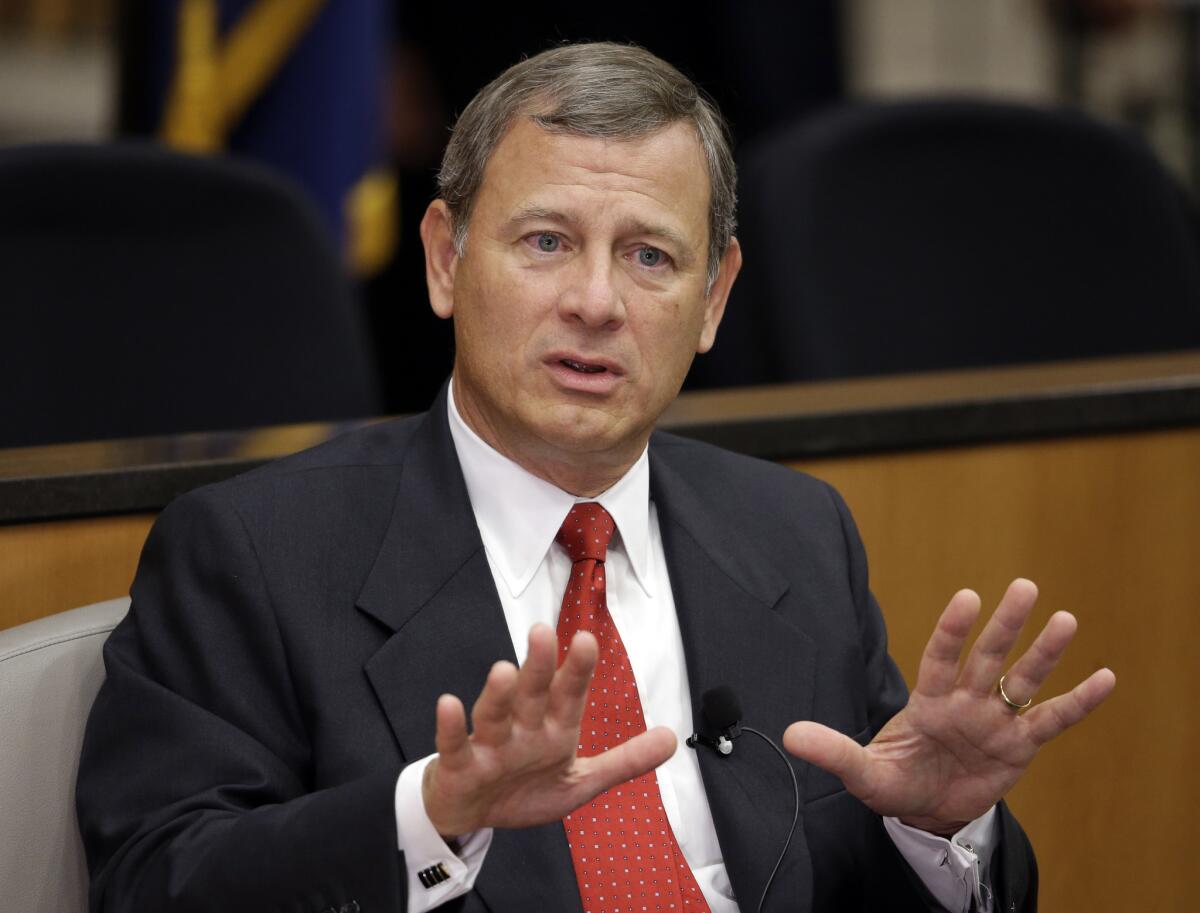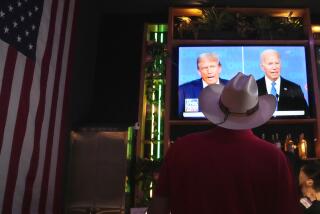Battle over Scalia’s seat feeds perception that Supreme Court is less neutral and more partisan

An election-year power struggle between a Democratic president and a Republican-controlled Senate is in many ways the worst nightmare for Chief Justice John G. Roberts Jr.
Reporting from Washington — The coming partisan battle over who will fill the seat of the late Justice Antonin Scalia is certain to fuel growing public perceptions that the Supreme Court is becoming more of a political body than a neutral forum for deciding cases based on the law.
The court has long tried to maintain the image of being distinct from the expressly political branches of the government. Although legal scholars disagree about how much the justices’ political views determine their decisions, the justices themselves have taken pains to insist that they don’t.
But repeated political battles over confirmations and the partisan forces that have swirled around Congress and the White House have all but eroded that sense of distinctiveness.
An election-year power struggle between a Democratic president and a Republican-controlled Senate is in many ways the worst nightmare for Chief Justice John G. Roberts Jr.
Earlier this month he warned against the politicization of the high court and said its standing would be damaged if the public came to see justices as political figures, particularly after bruising confirmation fights.
“We don’t work as Democrats or Republicans,” he told a law school audience in Boston.
Roberts also took aim at exactly the kind of partisan Senate confirmation process that is likely to emerge if President Obama makes good on his vow to quickly name a replacement for Scalia, who died over the weekend.
Noting that the last three Senate confirmation votes for Supreme Court justices fell largely along partisan lines, he said senators appeared to have a “different agenda” and that “the process is being used for something other than ensuring the qualifications of the nominees.”
So far that message appears lost on Democrats and Republicans, who see the chance to put their favored candidate into Scalia’s seat as crucial to achieving their political and social goals.
NEWSLETTER: Get essential California headlines delivered daily >>
It’s not unusual, of course, for justices to have sharply different ideological views. But this year’s confirmation fight comes at an unusual time for the court.
For the first time in modern history, the ideological divide of justices has mirrored their political affiliations: the liberals are Democratic appointees and the conservatives were named by Republican presidents.
This is quite a contrast from decades past, when Republican appointees such as William Brennan and Harry Blackmun became among the most liberal justices, and conservatives included Democratic-appointed Byron White. Republican appointees such as Lewis Powell and Sandra Day O’Connor were moderates who became important swing votes, a role now played by Republican appointee Justice Anthony M. Kennedy.
Obama’s two appointees — Justices Sonia Sotomayor and Elena Kagan — replaced the last two liberal Republicans: Justices David H. Souter and John Paul Stevens.
But though the ideological balance of the court did not change significantly, the perception did. Since 2010, when the court has divided 5 to 4, the split has usually fallen along partisan lines.
Legal experts say the chief justice is right to emphasize that decisions don’t necessarily fall along political lines and that justices have valid legal reasons for seeing cases differently.
See the most-read stories this hour >>
“There is a difference between judicial ideology and partisanship,” said Stanford University law professor Michael McConnell, a former U.S. appeals court judge appointed by President George W. Bush.
But others say Roberts may be fighting an uphill battle over the public’s perception.
“The chief is in a very difficult position,” said Irving Gornstein, executive director of the Supreme Court Institute at Georgetown University Law Center. “He understandably wants to assure the public the justices do not vote as Democrats or Republicans. If the public perception becomes that they are not just voting along ideological lines but voting their favored party, the esteem in which the court has been held will evaporate.”
Already this perception may be eroding the court’s standing, according to opinion surveys. A recent Gallup poll found that last year for the first time, half of respondents disapproved of the Supreme Court, compared with 29% in 2000. The percentage of those having “little confidence” in the high court has doubled since 1973.
Roberts has tried at times to bridge the partisan divide. He has sometimes crafted rulings that can bring together a large majority of the justices.
And he famously split from his fellow conservatives in two cases that upheld Obama’s healthcare law. Both times, he emphasized that Congress had passed a law and the court had a duty to uphold it where possible.
But in a sign of how the court is seen as increasingly politicized, Roberts was criticized by conservatives as a traitor rather than commended for trying to follow the law as he interpreted it.
For those votes, he has been called “an absolute disaster” by Donald Trump, the Republican presidential front-runner. Sen. Ted Cruz (R-Texas), who formerly lauded the chief justice, now says he agrees with Trump.
Both men have suggested that, if elected, they would seek Supreme Court justices who would overturn the court’s rulings on same-sex marriage.
Democrats are also more open about their plans to screen potential justices based on their politics and positions, rather than looking solely at their qualifications and experience.
“I have a bunch of litmus tests,” said Democratic front-runner Hillary Clinton during a debate this month. She said she would like to appoint a justice who would overturn the court’s Citizens United ruling, which opened the door for unlimited super PAC spending.
Some critics say the court has at times contributed to the public perception through such controversial decisions as Bush vs. Gore, which ended the 2000 election dispute in favor of George W. Bush.
And just two days after Roberts publicly warned against politicizing the court, he joined conservatives in a surprise 5-4 decision to block Obama’s Clean Power Plan rules from taking effect.
The decision raised familiar cries of partisanship and was a rare example of the court halting a president’s regulations before a lower court had reviewed them.
Republicans cheered the order. It is “a victory for the American people and our economy,” said House Speaker Paul D. Ryan.
Sen. Sheldon Whitehouse (D-R.I.) said it would be “seen as an infamous political action by the five Republican appointees on the Supreme Court.”
Twitter: @DavidGSavage
ALSO
How Scalia’s death may save teachers unions -- for now
Why evangelicals are splintering and what it means for the GOP
Analysis: Scalia’s death puts Supreme Court at the center of the presidential campaign
More to Read
Sign up for Essential California
The most important California stories and recommendations in your inbox every morning.
You may occasionally receive promotional content from the Los Angeles Times.











